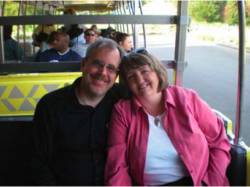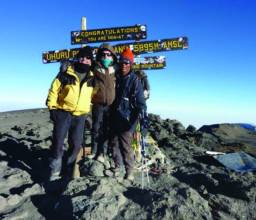 Frank & Jeanine at the Wild Animal Park
Frank & Jeanine at the Wild Animal ParkSIDEBAR: Frank Czopek’s Compass Points
Frank Czopek and his brothers used to go to the 1970s Detroit version of Craigslist — Trading Times — to buy two or three non-functioning Chevrolet Corvairs (air-cooled rear engine-mounted) cars, at $25 apiece.
They hoped to turn the junkers into a single functioning automobile over a weekend. Unfortunately, the results did not last long; so, the process was repeated often. But they sure had fun!
SIDEBAR: Frank Czopek’s Compass Points
Frank Czopek and his brothers used to go to the 1970s Detroit version of Craigslist — Trading Times — to buy two or three non-functioning Chevrolet Corvairs (air-cooled rear engine-mounted) cars, at $25 apiece.
They hoped to turn the junkers into a single functioning automobile over a weekend. Unfortunately, the results did not last long; so, the process was repeated often. But they sure had fun!
In all, Czopek estimates that at least 33 cars made it through the family’s backyard assembly line.
When not working on cars, Czopek attended a boarding school, St. Mary’s Preparatory, where two events transpired that helped define his future. Because the school food was not much to his liking, he soon developed a love for McDonald’s Big Mac hamburgers — a taste that has followed him through life.
The second event occurred his junior year, when math teacher Calvin Cathers discerned in Czopek an aptitude for math that had, up till then, never been evident. At the end of the school year, he made a recommendation that stuck with Czopek.
“Your math skills are very good, and you should go into engineering,” Cathers told him.
Today, that kid-from-the-neighborhood enthusiasm (and the humility born of constant experimentation) still lives in Czopek’s optimistic, exuberant manner.
It’s carried him through a career entwined with all aspects of the GPS Block II satellites (cesium clocks, and navigation and L-band payloads), to the early design efforts on the IIF navigation payload.
It culminated with 11 years as the program manager for the Boeing’s GPS Block II/IIA support contract and, today, his participation on the GPS Block IIF team that sent up its first satellite last spring.
Czopek’s acquaintance with the GPS satellites started in 1984 when few people knew about GNSS technology. At the time, he was working with another manufacturer of defense equipment.Wanting to show a family friend how easy it was to find employment in southern California, Czopek took her to a Rockwell International engineering job fair in Seal Beach.
In no time, Czopek found himself answering questions about his space mechanical design, digital, and assembly language skills. The manager sitting next to his interviewer leaned over and said, “I want him!”
Shortly thereafter, Czopek got two job offers. One, from his employer at the time, involved extreme weather testing in Alaska for an armored vehicle program on which he was working. The other came from Rockwell. With the latter offer, he’d get to use digital equipment that took advantage of his experience in assembly language programming and his mechanical background on a new United States space program called GPS.
Easy decision, he said.
Turns out, the manager from the interview was in charge of the Block II/IIA payload, and he became Czopek’s first boss on GPS.
But First, This Flashback
A lot happened in between Czopek ‘s Motor City adventures and the advent of the operational GPS constellation.
As a kid, Czopek remembers watching Walter Cronkite’s enthusiastic television coverage of the GEMINI launches, NASA’s human spaceflight program of 1965 and 1966. A meticulous German mechanical engineer named Günter Wendt, famous for his engineering rigor, oversaw the closure of each space capsule and was the last guy to see each astronaut. Czopek thought that looked pretty interesting.
This was one of the influences that inspired him to pursue mechanical engineering in college, and in 1980 he received a bachelor of science degree from Michigan Technological University (MTU). Located in Houghton on Michigan’s Upper Peninsula, MTU was known for cold winters and tight connections to Detroit, the center of the then-dominant U.S. auto industry.
But Czopek knew he wanted to do something other than cars. With the excitement of those early launches in mind, he set his sights on space. After interviewing with an MTU alumna at TRW Inc., developers of the first ICBM and parent company of many aerospace and automotive parts corporations, Czopek was easily lured west to sunny southern California in 1980 for a job with Boeing, then called Hughes Aircraft.
He didn’t come alone. At MTU, Czopek had met a girl. And one day, while he sat on top of a washing machine waiting for the spin cycle to finish, she offered him a Big Mac. One thing led to another, and Czopek married Jeanine Bowman in 1982.
In California, Czopek started as a mechanical designer on space hardware but became interested in the possibility of computers controlling systems (such as heating and lights) in homes, a field that spilled over into the early days of embedded software programming.
In one of his first jobs, Czopek needed to create an acceptance test for a tank’s ammunition magazine. He decided to use Assembly Language to use the math routines needed to calculate running torque but was limited to only a one-bit processor, which required him to learn Boolean math and Karnaugh maps.
Along the way, he also learned how to design and interface with the 10-horsepower motors, shaft encoders, and control systems — also with a one-bit processor. These skills required the ability to synchronize timing between several concurrent processes, which brought his resume to the attention of Rockwell’s Space Systems Division at that fateful job fair.
Block II: Making It Happen
When Czopek made the move to Rockwell in 1984, he became a member of the company’s GPS Block II payload system engineering team. At the time, the Block II qualification satellite was in the middle of testing, and the first hardware for the Block II production program was being built.
The schedule supporting the first launch in 1986 aboard the space shuttle was aggressive and included a vigorous production rate of seven satellites per year. Czopek remembers juggling three satellite configurations between two different cost structures.
“While the Block II satellites in production required fewer functions than the GPS 12 (qualification) vehicle, we added more functions to Block IIA satellites later in the production line,” he said.
Challenges and opportunities appeared everywhere. Czopek’s team worked all aspects of the design, from the test floor to the unit vendors and segment interfaces, to figure out if the satellites performed as required by the interface, and if they did not, what had to change to make sure the system could meet user expectations.
Up until that time, Czopek was a lead guy on the engineering team, but he neither managed the program nor helped shape GNSS. He recalls the point at which that all changed. It started with being selected as NAV payload lead for the IIR proposal.
While working on this proposal, bigger questions of GPS sustainment planning began to arise. He participated in three more proposals that revolved around balancing the minimum requirement for a full constellation with the need for continuous, high-quality coverage that met evolving GNSS needs (M-code and civil signals).
“Those proposals boiled down to when to launch the next GPS satellite with what capabilities and at what cost,” Czopek says of the sustainment role.
“Those meetings opened windows for me into the minds of the GPS leadership as they struggled with planning. The opportunities and risks of these discussions seemed enormous.”
Czopek was so busy on the next-generation satellite proposals that one day he came in to the office and someone had to tell him that Boeing had launched GPS 14, the first GPS Block II satellite. “About the time we handed in the [new] proposal, the Block II navigation payload was activated,” he recalls.
After the win of the IIF proposal, the GPS wing awarded a separate II/IIA support contract. Boeing’s management took a gamble and promoted Frank to program manager of that contract, which came in on time and under budget. It remains a highlight of his years with the program.
GPS IIF: Pulse Line
By the time the GPS IIF program began, Czopek was fully immersed in GPS. He enjoyed participating in these discussions and the challenge of tying the old lessons to the new challenges to come up with a solution.
He began monitoring some of the other GNSS systems under development and heard the same questions and debates: How do you sustain and improve accuracy, meet emerging needs, and make it all affordable without interfering with current navigation services?
And he looked at the issues of the future: Is the current cost curve for launches sustainable, as constellation size and satellite mass increase? Where is the industry going? What innovation needs does it have?
In a partial answer to his questions, Czopek is now working with a GPS IIF program team on system engineering and interface control document processes. Their job is to make sure that the unit hardware is ready for assembly on the satellite. The IIF generation of space vehicle is the first being produced using Boeing’s pulse line to assemble satellites.
The GPS pulse line is similar to a traditional airplane assembly line, where the satellite moves from one work area to the next in a steady rhythm to increase speed, efficiency and quality. Today, it takes 10 months for a IIF satellite to go through each of the 14 workstations on the pulse line.
“Our goal is to get that down to eight months, as we gather lessons learned, come up with new ideas and just get more practice at it,” Czopek said.
Sounds like the Frank Czopek of 1972 — as with the family’s backyard Corvair project, he’s still involved with the heavy lifting and getting things off the ground.
The 1972 Corvair Assembly Team
Here’s how the Czopek brothers did it.
On weekends, Frank and his brothers Greg and Pete paid $25 apiece for “transportation specials.” They usually ended up with rear engine–mounted, air-cooled Chevrolet Corvairs, because these were the cheapest. The goal: to get one fully functioning car out of the deal.
The Corvairs always seemed to need brakes and a clutch which required them to remove the engine. To do this, Frank’s youngest brother Pete would scoot under the car. All three brothers then removed the engine bolts causing the 400-pound engine to drop on Pete’s chest.
Quickly, Greg would raise the rear of the Corvair up while Frank would grab hold of Pete’s legs to pull him and the engine out from underneath the car. Frank and Greg than had to lift the engine off Pete’s chest so that he could breathe.
To install the engine, all they had to do was reverse the steps. This process was improved when cardboard was placed under Pete to make his pulling out easier and further refined when they got a dolley.
(Kids, don’t try this at home.)



